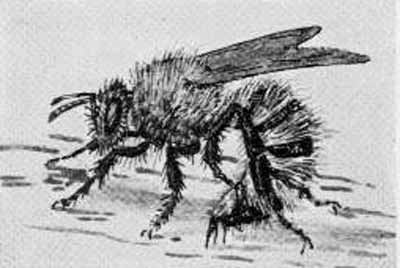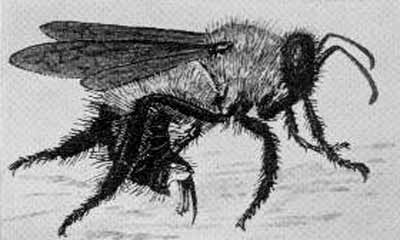The Stinging Sorority, Page 2
By S. F. AARON
All insect stings are endowed with feelers that are apparently organs of sense. The sheaths of the bees act this part, with an evident function not unlike the palpi of the mouth parts. The nature of the object to be stung is ascertained by them. Bees held by forceps will not often try to sting any object that to them does not seem antagonistic, as an apple, a twig or leaf; but if a finger is offered there is no hesitation on the part of the bee. After I had rubbed a smooth stick against my hand, that a honey-bee would nor sting until it had the flesh odor, the bee readily tried to sting the stick, and a bumble-bee showed the same tendency. Forceps evidently seem antagonistic, or offer negative influence. The muscular action back of the sting is sufficient to force it through the toughest callosity.
We can understand the value to the hive, if not to the individual bee, in having the sting become detached and continue to force poison into the wound. Undoubtedly a bear, raccoon, opossum or skunk with a score or more of remaining stings continuing to pump and pain might be somewhat disinclined further to rob the hive of the contents, no matter how delectable the feast.

A FRIENDLY SOUL: A honey-bee
There is a very considerable difference in the venomous strength or power of bee and wasp stings. The virulence may be governed somewhat, but not entirely, by the size of the insect. The little swift-flying, burrowing bees, Andrenidae, cause no greater hurt than the western agricultural ants. The very small sand-burrowing wasps, Oxybelidae, have such weak stings that not only can they hardly puncture one's finger, but when they do get through the thinner skin, the result is but a severe itching like that caused by a single pustule of poison ivy. These insects crush their fly victims with their jaws; their stings are evidently not powerful enough to put them to sleep.
Quite different are the little yellow-jackets, which not only are eager to sting when their nests are threatened, but inject enough poison to make the recipient fully aware of it. Yet I have known a toddling child to be covered by yellow-jackets and stung all over and hardly to be made ill. If half the number of honey-bees had been as attentive the baby would have died. There is an authentic record of honey-bees killing a crippled but healthy horse.
Far less severe than that of the yellow-jacket is the sting of the long-bodied digger wasp, Ammophila. It normally paralyzes caterpillars as large as itself, but this accomplishment marks the height of its powers. As though it knew the futility of its poison it cannot be induced to use its sting in defense of its burrow. The same may be said of the mud-dauber wasps, Scelephron and Pelopaeas, and of the jug-makers, Eumenes. An occasional stab from these insects is felt by the careless collector, but can be considered of small and brief importance.

THE HOTTEST WARRIOR OF THEM ALL: The bumble-bee
The solitary wasps as a class and with only a few exceptions are not powerful stingers; their venom, while no doubt useful as a protection against many foes, seems to have been developed principally for the purpose of rendering their prey helpless.
The caterpillar and grasshopper-catchers rarely kill their victims outright, though frequently stinging them many times, and only about half the spiders caught and stung repeatedly by the digger wasps and the mud-daubers are killed at once. It is probable that the wasps withhold a portion of their poison, involuntarily perhaps, for they have an abundance of it. It is a fact that the insertion of a fine insect pin into the body of a spider will cause it to die quickly, so that in some cases, especially with small spiders, there would seem to be little need of poison for the wasps purpose.
The so-called wood-boring wasps, Trypoxylon, which are not borers at all, but merely users of holes in any convenient substance, possess also very weak poison, as I well know from having had it demonstrated upon me from the insect net. As for the semi-social, stout-bodied digging wasps of more than medium size, Bombex, it is said that they get into something of a rage when their nest is hastily approached, but do not attempt to use their stings. On the other hand the little burrowing bee-catchers, Cerceris and Philanthus, sting with such virulence that their bee and leaf beetle victims are killed at once.
The gold wasps or cuckoo flies, Chrysididae, do not appear to possess poison glands; they rarely sting, even if taken by the fingers from the net. If defense is attempted it results in but a mere puncture like the deep prick of a fine needle. A similar stab is given by certain larger, nonpoisonous Ichneumonidae.
No doubt the larger the insect the bigger its poison sac, but that does not seem to be the chief influence. We have an example of relative size and strength of venom as between the big sand hill hornet, Sphecius, and members of the hairy sand ant family, Mutillidae. These latter are, with the exception of the bumblebees, Bombus, the most virulent of all stingers. The length of their stilettos perhaps accounts in part for the severe result.
The sand hornet makes victims of the cicada, as is well known; the sudden cessation of the husky homopter's buzzing resistance after one quick stab attests to the deadly character of the poison injected. The Mutilla minds its own peculiar business, its bright red and black colors warning hungry birds not to touch it.
I have been stung once by each of these interesting insects, by the big sand digger on the thumb when she was going out of the net into a cyanide jar. The stab felt like the plunge of a red hot needle; the bottle and lifted cork dropped, spilling the solution and liberating the valiant objector. But the hurt was not lasting and the member swelled but slightly.
I came into contact with the red and black hairy sand ant, Sphaerophthalma occidentalis, when beginning my active collecting efforts as a boy. There before me was a slowly running, gaudy thing that was some new kind of a hirsute ant and it was getting away toward a tangle of long grass. In that section there are no true ants that have stings; therefore, eager fingers closed on the creature. And unclosed! I hardly could believe the creature was not a whole and condensed bee hive. I flung it from me and it got away. I have collected many of that species and others of its near relatives since, but tweezers have been used, or else the specimens sought have been made to run into an open cyanide jar.
 Printer-friendly version
Printer-friendly version
